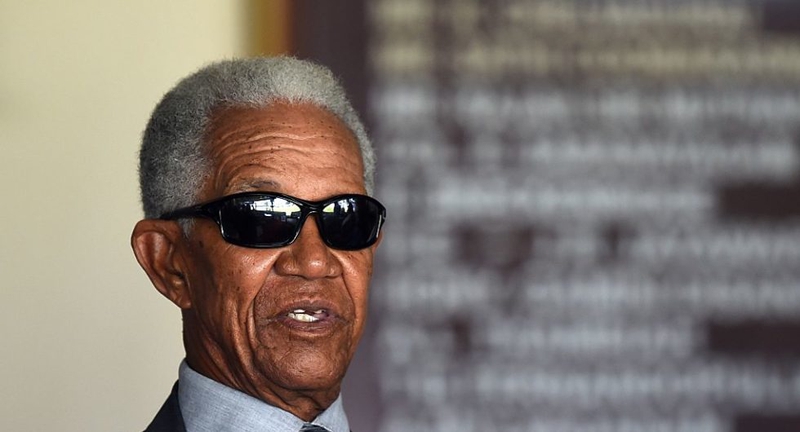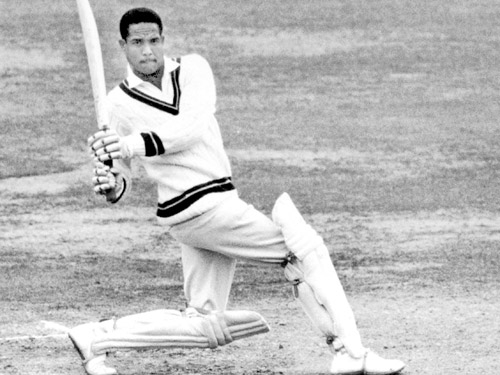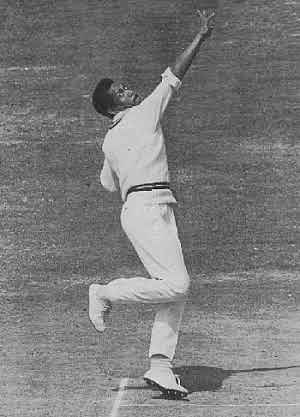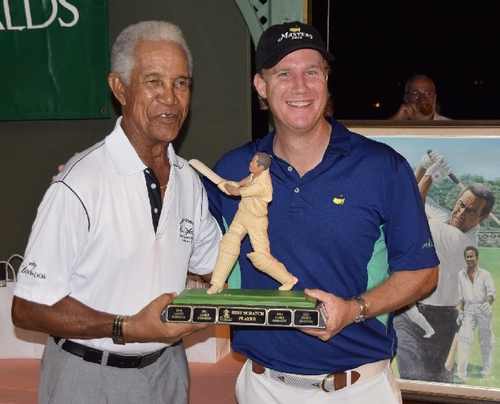Garry Sober was born in Bridgetown, Barbados, Sobers made his first-class debut for the Barbados cricket team at the age of 16 in 1953, and his Test debut for the West Indies the following year. Originally playing mainly as a bowler, he was soon promoted up the batting order. Against Pakistan in 1958, Sobers scored his maiden Test century, progressing to 365 not out and establishing a new record for the highest individual score in an innings. His record was not broken until Brian Lara scored 375 in 1994. Sobers was made captain of the West Indies in 1965, a role which he would hold until 1972. He would also captain a Rest of the World XI during their 1970 tour of England.

Overall, Sobers played 93 Tests for the West Indies, scoring 8032 runs at an average of 57.78, and taking 235 wickets at an average of 34.03. He has the fourth highest batting average in Test cricket in the list of cricketers with more than 5,000 runs. In his 383 first-class matches, he scored over 28,000 runs and took over 1000 wickets, having spent time with South Australia and Nottinghamshire towards the end of his career. Sobers was knighted by Queen Elizabeth II in 1975 for his services to cricket. He became a dual Barbadian-Australian citizen through marriage in 1980.[3][4] By an act of Parliament in 1998, Sobers was named as one of the ten National Heroes of Barbados.
#1936–1954: Early years
Garfield St Aubrun Sobers was born on 28 July 1936 to Shamont and Thelma Sobers of Walcott Avenue, Bay Land, St Michael, Bridgetown, Barbados,[7][8][9] and was the fifth of six children.[7][10] At birth he had two extra fingers, one on each hand, which he removed himself during childhood, "with the aid of catgut and a sharp knife."[11][12] Sobers was only five when his father died at sea in January 1942, after his ship was torpedoed by a German U-boat.[7]
From an early age, Sobers demonstrated the talent and ability to play with great skill almost any sport involving a ball, particularly cricket, football and basketball.He and his similarly talented brother Gerald helped their Bay Street Boys' School team to win the primary school Inter-School Cricket championship for three consecutive years.When he was 13, he was recruited to play for two cricket teams. These were the Kent St Philip club in the Barbados Cricket League (BCL) and the Wanderers club,[dubious – discuss] located at Bay Land, in the Barbados Cricket Association (BCA). Garnet Ashby, captain of Kent St Philip, told him that this was his opportunity to play cricket with "the big boys".
Sobers gained useful experience by bowling to Wanderers batsmen, including West Indies Test player Denis Atkinson, at practice in the nets and soon developed his great skill as a left arm spin bowler. More importantly for his career, he was observed by Inspector Wilfred Farmer, captain of the Police team in the BCL First Division. Farmer offered Sobers a chance to play for Police in the 1951–52 season while he was still only 15.In the 1952–53 season, Sobers was invited to the Barbados trials for the colony's tour match against the Indian touring team at Kensington Oval, Bridgetown. He was initially selected as 12th man but then made the team itself when Frank King was forced to withdraw.He therefore made his first-class debut on 31 January 1953, aged only 16. Batting at number nine, he scored 7 not out in his only innings but made an immediate impression as a bowler, taking 4/50 and 3/92.
A full year passed before Sobers, now 17, made his second first-class appearance, again playing against a touring team. He batted at number five against Marylebone Cricket Club (MCC), scoring 46 and 27; and took two wickets in the match. He had shown enough talent in these two matches to be selected for West Indies and his third first-class appearance was his Test debut.

International cricket career
#1954–1957: Early Test career
Sobers had progressed quickly and made his Test debut in March 1954, aged 17, against England at Sabina Park in Kingston, Jamaica for the Fifth and final Test, after Alf Valentine had fallen ill. Sobers was selected as a bowler, despite only mediocre performances against England for Barbados. He made a good impression by taking 4/75 in England's first innings, including a wicket in his opening over. Sobers also scored 14 not out and 26 batting at number nine; however, England won the match by nine wickets.
Australia toured the West Indies in 1954–55, and their all-rounder Keith Miller thought that Sobers would become a better batsman than bowler despite batting in the lower-order. Sobers was not selected for the First Test, which the West Indies lost by nine wickets. However, he regained his place for the Second Test in Port of Spain, Trinidad and Tobago. The match was a high-scoring draw, with Sobers scoring 47 and eight not out. He was barely used with the ball, bowling three overs for ten runs, as Australia amassed a first-innings total of over 600.Sobers was given a further opportunity in the next Test in Georgetown, Guyana (British Guiana at the time) in South America. Despite scoring only 12 and 11 with the bat, he took three wickets in the Australians' first innings. Nevertheless, Australia won by eight wickets.West Indian captain and opening batsman Jeff Stollmeyer twisted his ankle after treading on a ball ahead of the Fourth Test in Barbados, "triggering huge debate about who should open."Eventually, Sobers was chosen to open the innings after Australia had amassed another total of over 600. Sobers had a suspicion he might be asked to do the job. "I couldn't see them sending in anyone else — I was a bowler with a little ability as a batsman and they wanted someone to help see off the shine and protect the three W's." Sobers struck his first three deliveries for boundaries, all from the bowling of Miller. In the fast-bowler's second over, Sobers hit him for another three fours. He was eventually dismissed for 43 out of a first-wicket partnership of 52 with JK Holt.The match was drawn, and Sobers took one wicket in the Australians' only innings, before scoring 11 in the West Indies second innings.The home team were again defeated in the Fifth and final Test in Jamaica. Sobers performed with the bat, however, scoring 35 not out and 64.

Sobers went on his first overseas tour in the early months of 1956 when, aged 19, he was part of the West Indian tour of New Zealand. The series was not successful personally for Sobers, who struggled on the foreign batting wickets. West Indies pitches had little or no grass to speak of, while in New Zealand the pitches were green. "I took one look and asked myself how I could possibly bat on that? How could I make runs? I was out before I even walked to the crease," Sobers later wrote.Playing in all four Tests, he totalled 81 runs and two wickets. As a batsman, Sobers needed time to develop at Test level and, in nine Tests as a teenager, he scored only one half century, and averaged 29.33 with the bat.
He was sent home from New Zealand early to play an unofficial Test match against an England team that included feared fast-bowler Frank Tyson. After struggling to cope with Tyson's pace, Sobers managed to score a half-century, raising hope that he would be selected for the upcoming tour to England, something he considered unlikely after his lack of form.In the first trial match to help select the squad for the upcoming tour, Sobers scored a century in Trinidad. The matches also saw Sobers get his first look at West Indian cricket politics. Wes Hall and Frank Mason were competing for a single place in the touring party, and Sobers and Everton Weekes decided they "would take on Mason and knock him out of the firing line to try and get our fellow Bajan (countryman) Wes in the team."The pair attacked Mason, while they defended Hall in a tactic that paid off with Hall selected, despite Sobers believing Mason was the better bowler at the time.
Sobers toured England for their summer in 1957. He played his first match against the Jim Swanton XI in April, and was surprised about how cold the conditions were, often causing him to wear two or three jumpers. His performances with the bat throughout the five Test series were classed as mediocre, scoring 320 runs at 32, with three half centuries. On the bowling front, Sobers struggled, taking five wickets at 71. It was in the final Test at The Oval that Sobers gained the attention of critics with defiant batting amid a disappointing team performance. The condition of the pitch was subject to criticism and described by Wisden Cricketers' Almanack as "a strange sight".After England had scored 412, the West Indies were easily dismissed for 89 and 86 by the Surrey spinners Jim Laker and Tony Lock, who were playing on their home ground. Batting at number 3, Sobers made 39 and 42, while none of his colleagues passed 30 in either innings. In its summary of the tour, Wisden said: "(of the newcomers) Collie Smith, Sobers, Rohan Kanhai and Roy Gilchrist were particularly impressive"; adding that "to Sobers, a tall left-handed all-rounder, fell the distinction of hitting the highest score of the tour: 219 not out against Nottinghamshire at Trent Bridge. Sobers undoubtedly was a very fine stroke-player who should go far".
#1958–1964: 365 not out
At this stage of his career, Sobers had frustrated his admirers by failing to convert good starts into high scores. He had reached double figures in 18 of his 22 Test innings, although his highest score was still only 66. But, in the three years following the 1957 tour, he fulfilled his promise. In his next 24 Tests, he scored 2,250 runs at the exceptionally high average of 93.75. In 1958, he scored his maiden Test century against Pakistan in Kingston and expanded it to an unbeaten 365, breaking the world record Test score of 364 set by England's Len Hutton in 1938. Sobers batted for 614 minutes and scored 38 fours but, unusually in such a large total, no sixes. At 21 years and 216 days, he is the youngest player to break the individual scoring record in Tests, and remains the youngest triple-centurion.Sir Garfield Sobers set the world records for the highest maiden test ton(365*) as well as becoming the first batsman in test history to convert his maiden test ton into a triple ton.He made 824 runs with three centuries in the five Tests against Pakistan, and followed this with 557 runs and three more centuries on the West Indies tour of India in 1958–59. Sobers underwent trauma following the death of Collie Smith in September 1959, but he continued to play cricket successfully. In the home Test series against England in 1959–60, he scored three centuries in five matches, totalling 709 runs.
Largely inspired by new West Indies captain Frank Worrell, who was a close personal friend, Sobers had an outstanding 1960–61 series in Australia. He scored a celebrated 132 on the first day of the First Test at Brisbane Cricket Ground, the match which resulted in the first Tied Test. Wisden confirmed that "some observers considered it the best hundred they had ever seen".Sobers scored 430 runs in the series, which Australia won 2–1, with two centuries; his fielding was outstanding and he took 12 catches.He felt he had "had a good series, starting badly but then coming on" and a very positive outcome for him was to receive an invitation from Don Bradman to play for South Australia in 1961–62.
Sobers took 15 wickets in the 1960–61 series, including a best analysis of 5/120, at an average of 39.20, and his bowling allowed Worrell to play an extra batsman in the final three Tests, thus using Sobers for the first time as a designated all-rounder, a role in which he became the dominant player in world cricket over the next decade, being awarded the Wisden Leading Cricketer in the World title (retrospectively) eight times in 13 years. Sobers was never a prolific wicket-taker in Test cricket, and his average of three wickets per game in this series typified his whole career. Overall, he took 235 wickets in his 93 Tests at an average of 34.03 and was more effective when operating as a pace bowler. His best performance was 6/73 and, although he achieved five wickets in an innings six times, he never took ten in a match.
His success continued in the next two series at home to India in 1961–62 and away to England in 1963. He was elected Wisden Cricketer of the Year in 1964, and then succeeded Worrell, who had retired, as West Indies captain for the 1964–65 home series against Australia.
1965–1974: West Indies captaincy
Sobers enjoyed immediate success as West Indies captain when his team defeated Australia by 179 runs in the First Test at Sabina Park. West Indies went on to win the series 2–1 and so claim the new Frank Worrell Trophy. This was the first time West Indies had beaten Australia in a Test series.

He enjoyed spectacular success in England in 1966 and was widely acclaimed as "King Cricket". In the five Tests he scored 722 runs at an average of 103.14 with three centuries, and had 20 wickets at 27.25, as well as taking 10 catches. West Indies won the series 3–1, with one match drawn. His status was celebrated at that time by the Trinidadian calypso artist Mighty Sparrow, with his song "Sir Garfield Sobers".
In 1966–67, Sobers captained the West Indies team to India in 1966–67 and they won the series 2–0 with one match drawn.
He lost a series for the first time in 1967–68 when West Indies were surprisingly beaten at home by England. Four matches were drawn and England won the Fourth Test at Queen's Park Oval following a controversial declaration by Sobers which enabled England to score the necessary 215–3 to win at just four runs an over.
In 1968–69, Sobers captained the West Indian cricket team in Australia in 1968-69 but they lost the series 3–1 and then drew a three-Test series in New Zealand 1–1.
In 1969, West Indies lost 2–0 in England with one match drawn.
Sobers captained West Indies for the five-Test home series versus India in 1970–71. India won the series 1–0 with four matches drawn. A year later, Sobers led West Indies in five home Tests against New Zealand and all five were drawn.
Sobers was succeeded as West Indies captain by Rohan Kanhai for the 1972–73 home series against Australia. Sobers did not play in that series but returned to play under Kanhai in England in 1973. He played his last Test in March 1974 at Queen's Park Oval against England.
I hoped you like my post.

Comments